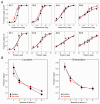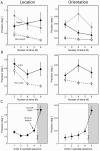Dynamic shifts of limited working memory resources in human vision
- PMID: 18687968
- PMCID: PMC2532743
- DOI: 10.1126/science.1158023
Dynamic shifts of limited working memory resources in human vision
Abstract
Our ability to remember what we have seen is very limited. Most current views characterize this limit as a fixed number of items-only four objects-that can be held in visual working memory. We show that visual memory capacity is not fixed by the number of objects, but rather is a limited resource that is shared out dynamically between all items in the visual scene. This resource can be shifted flexibly between objects, with allocation biased by selective attention and toward targets of upcoming eye movements. The proportion of resources allocated to each item determines the precision with which it is remembered, a relation that we show is governed by a simple power law, allowing quantitative estimates of resource distribution in a scene.
Figures




Comment in
-
Comment on "Dynamic shifts of limited working memory resources in human vision".Science. 2009 Feb 13;323(5916):877; author reply 877. doi: 10.1126/science.1166478. Science. 2009. PMID: 19213899 Free PMC article.
References
Publication types
MeSH terms
Grants and funding
LinkOut - more resources
Full Text Sources
Other Literature Sources

